History of the Jews in North Macedonia
The history of the Jews in North Macedonia stretches back two thousand years.
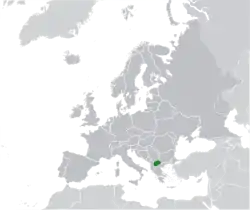
| Part of a series on |
| Jews and Judaism |
|---|
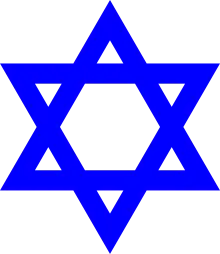 |
|
Part of a series on the |
|---|
| History of North Macedonia |
 |
| Chronological |
|
| Topical |
| Related |
|
|
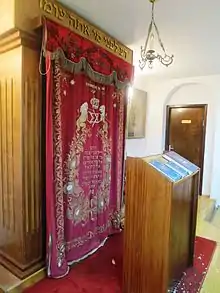
North Macedonia, officially the Republic of North Macedonia, is a country in the Balkan Peninsula in Southeast Europe. It is one of the successor states of Yugoslavia, from which it declared independence in September 1991 under the name Republic of Macedonia.
The history of Jews in the territory of the present-day Republic of North Macedonia began during Roman antiquity, when Jews first arrived in the region. Today, following the Holocaust and emigration, especially to Israel, around 200 Jews remain in North Macedonia, mostly in the capital, Skopje and a few in Štip and Bitola.[1][2]
Ancient Roman times
The first Jews arrived in the area now known as North Macedonia during Roman times, when Jews fled persecution in other Roman territories, with some settling in the Roman territory of Macedonia.[3] The presence of Jews in North Macedonia is attested by Agrippa's letter to Caligula.[4]
At Stobi, in 165 AD, Tiberius Polycharmus, who is designated “father of the synagogue,” converted his villa into a synagogue containing a prayer hall, a dining hall (triclinium) and a portico, reserving the upper story of the complex for his residence and that of his successors. The information comes from a very impressive and informative inscription, arguably the most important one found to date in a Diaspora synagogue.[5][6][7]
The remnants of a Jewish synagogue excavated in Stobi (North Macedonia) date back to that period and the conclusion that a developed Jewish Community existed in that locality those days is based on these findings.
Medieval times
The Jewish community persisted in North Macedonia (as well as in the rest of the Macedonian region) after Roman rule. The medieval Jewish population of North Macedonia consisted until the 14th-15th century primarily of Romaniote Jews.[8] The First Crusade devastated the Jewish population in Pelagonia and Skopje. However, the Jews in North Macedonia continued to have prominent members of their communities. For instance, Leo II Mung, the Philosopher, converted to Christianity and succeeded Theophilactus of Ohrid as the archbishop of Ohrid from 1108 to 1120.[9] A leading Jewish scholar, Judah Leon ben Moses Mosconi, born in Ohrid in 1328, wrote commentaries stating that incorrect interpretations of scripture often resulted from neglect of grammar.[10] He later became the physician of the king of Majorca, where he assembled a vast library that was used by scholars for centuries to come.[11] The first known synagogue in Skopje, Beth Aharon, was built in 1366.[12]
Ottoman Rule and Sephardic migrations
The area's Jewish community remained small well into Ottoman times, with the next major influx of Jews to the area coming with the Spanish and Portuguese Inquisitions, and Sultan Bayezid II of the Ottoman Empire welcomed Jews who were able to reach his territories. They were granted significant autonomy, with various rights including the right to buy real estate, to build synagogues and to conduct trade throughout the Ottoman Empire.[13] Wealthy merchant cities in the present-day North Macedonia such as Skopje, Monastir (present-day Bitola) and Štip attracted many Jews. Jews in this area prospered in the fields of trade, banking, medicine, and law, with some even reaching positions of power. The Jewish cemetery in Bitola was established in 1497, soon after the first Sephardic Jews moved to the area. The cemetery is the oldest Jewish cemetery in North Macedonia, if not in the Balkans overall.
Relations between the Jews and the local non-Jewish population were generally good.[14] Confirmation of good conditions for Jews in North Macedonia (and the broader Macedonian region) and Ottoman Europe in general comes from a 15th-century letter from the Macedonian Jew, Isaac Jarfati, sent to German and Hungarian Jews advising them of the favorable conditions in the Ottoman Empire, and encouraging them to immigrate to the Balkans.[15] An Italian traveler wrote in 1560 that in Skopje Jews exceeded other populations in number.[16] In the 17th century, there were 3,000 Jews and two synagogues in Skopje, Beit Aron and Beit Yaacov.[17] In 1680, Nathan of Gaza died and was buried in Skopje.[18] His burial place was a pilgrimage site after his death,[18] but it would not become a permanent pilgrimage site, since it was destroyed in World War II.[19]
At one point, Bitola had nine synagogues, Skopje three and Štip had two.[20]
Several notable Jewish philosophers are born or lived for a time in North Macedonia, including Samuel de Medina, Josef ben Lev, Shlomo Koen, Kirco Blazevski, Jaakov tam David Yahia, Ishaak ben Samuel Adrabi, Aharon ben Josef Sason, and Salamon.[21]
Piccolomini's burning down of Skopje in 1688–1689 and a massive fire in Bitola in 1863 significantly diminished the Jewish population in North Macedonia in the two largest Jewish centers.[16] In 1689, the Jewish population of Skopje was 3,000 of the total 60,000 population.[22]
The Jewish community was almost entirely Sephardic, and most spoke Ladino at home as opposed to Hebrew. 1895 the Alliance Israelite Universelle established a school in Bitola. More than 30% of Macedonian Jews spoke French at this time.[16]
Jews also took part in the liberation movement against Ottoman rule. A great number of Macedonian Jews participated in the Ilinden-Preobrazhenie Uprising. One of the most notable participants was Rafael Moshe Kamhi who led one of the rebel groups. It was he who took part in the early activities of the movement under the nickname Skanderbeg (Skender-beg). He headed a unit in Debar during the uprising of 1903.[23] Mentes Kolomonos, Santo Aroesti, the Muson brothers and Avram Nisan are other known participants in the uprising who collected weapons and provided rebels with money.,[24][25]
Jews from modern-day North Macedonia got their citizen rights after the region became a part of Kingdom of Serbia.[26]
Distribution
Prior to World War II, the Jewish community of Vardar Macedonia (the area roughly corresponding to the borders of the present-day republic) was centered on Bitola (approximately 8,000 Jews), Skopje (approximately 3,000 Jews)[14] and Štip (approximately 500 Jews).[27] The Jewish communities during World War I in smaller areas, like Dojran and Strumica, that were close to the front line, were significantly affected by the fighting and fled the area. The partition of the region also adversely impacted the Jews in the smaller centers since it deprived them of free flow for most of their merchant activities to the largest Jewish trading center in the Balkans, Thessaloniki.
World War II and the Holocaust

In March 1941, Bulgaria became an ally of the Axis Powers and[28] in April 1941 the Bulgarian army entered Vardar Macedonia, in an effort to recover the region, which it saw as a natural part of its own national homeland. Since its independence movement began in late 19th century, Slavic speakers of Vardar Macedonia had been trying to free itself from Turkish (and later Serb) rule, either as an autonomous state or as part of Bulgaria proper.[29]

Although Bulgaria had effectively occupied the region, German authorities, who were in charge, recognised only the Bulgarian military administration and not the civil one. The Bulgarian occupational zone included neither Thessaloniki, with its over 55,000 Jews, nor the westernmost part of Vardar Macedonia, including the towns of Debar, Struga, and Tetovo, which were part of Italian-occupied Albania.[29] On October 4, 1941, the Bulgarian authorities enacted a law prohibiting Jews from engaging in any form of commerce, and forcing them to sell their businesses to non-Jews. However, such laws were not a novelty for the region since the Kingdom of Yugoslavia had had its own anti-Semitic law enacted as early as 1939.[30] The Bulgarians then ghettoized the Jews of Bitola, forcing them to move from the Jewish areas of the town, which were relatively affluent, to poorer areas of the town.[27]

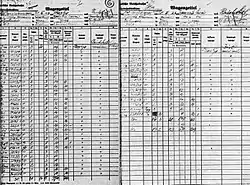
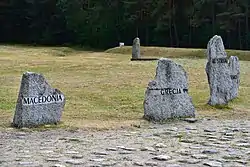
Bulgarian authorities had already adopted an antisemitic law called "Law for Protection of the Nation" in January 1941.[28] According to the U.S. Holocaust Museum, "on October 4, 1941, the Bulgarians enforced an extraordinary measure that prohibited the Jews of Macedonia from engaging in any type of industry or commerce."[32] Over the course of 1942, they enacted increasingly harsh measures against the Jews under their control in Vardar Macedonia, as well as in occupied northern Greece. Some of the harsh demands by the Bulgarian government were that all "Jewish households hand over 20 percent of the value of all assets."[33] The harsh measures culminated in 1943 with the deportation, upon orders from Germany, of "Macedonian Jews"[34] and Greek Jewry to the Bulgarian border on the river Danube. From there they were transported with German boats and trains to the German death camp Treblinka in occupied Poland.[28][35][36] Jews from Skopje, Stip, and Bitola, approximately a total of 7,215, were kept in "crowded, filthy conditions in four warehouses at Monopol" for 11 days before being put on trains to Treblinka.[37][38]
Nazi Germany even requested that Bulgaria finance the deportations. On February 22, 1943 an agreement was signed between Theodor Dannecker, the special Nazi envoy sent to facilitate the deportations, and the Bulgarian Commissar for Jewish Affairs, Alexander Belev to deport 20,000 Jews (12,000 from Vardar Macedonia and Thrace and 8,000 from Bulgaria proper). This is the only agreement that a country ever signed with Nazi Germany for deportation of Jews. Bulgaria had to pay all transportation costs and promise never to claim those Jews as citizens. . Bulgarian authorities were asked to report to the Germans the actual deportation costs . However, as discovered in the German Archives recently, the Bulgarian Government specifically discussed with Nazi Germany what it would cost to deport the Jews of Bulgarian-occupied Vardar Macedonia and Thrace. Documents show that Nazi Germany paid to the Bulgarian Government 7,144.317 leva, for the deportation of 3545 adults and 592 children to the killing camp at Treblinka.[39]
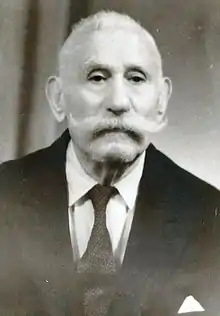
Many Jews joined the partisans fighting the Nazis in Yugoslavia. In Vardar Macedonia, Haim Estreya Ovadya, a Jewish woman from Bitola, was among the first women to join the partisan movement in 1941. The day before the deportations, the Central Committee of the Communist Party of Macedonia gave the Jewish community advance warning of the deportation. Shelters were organized, as well as connections to the partisan units, but unfortunately, few Jews believed that a program for their destruction was underway and chose to stay together in the ghettos instead.[40] In contrast with the old Bulgarian territories, where widespread protests against the deportations took place, including petitions to the Sofia government, in Vardar Macedonia such organized movements were lacking.[41] In the early morning of Thursday, March 11, 1943, Bulgarian police monitored by the SS, rounded up the entire Jewish population of Skopje, Bitola and Štip.[14][42] The population was sent to a temporary detention center at "Monopol" the state tobacco warehouse in Skopje.[27][42] Among 7,215 people who were detained in warehouses there were:[43]
- 539 children less than 3 years old,
- 602 children age 3 to 10 years
- 1172 children age 10 to 16 years
- 865 people over 60 years old
- 250 seriously ill persons (who were tied to their beds)
- 4 pregnant women who gave birth while in the detention camp.
- 4 people who had died upon arrival in the camp.
The Bulgarian government asked for a breakdown of the German plans for the eventual deportees, and was told that roughly one-half will be employed in agriculture in Greater Germany and one-fourth, reported to be semi-skilled laborers, will be "allowed to redeem themselves" by "volunteering to work" in the war industries of the Ruhr, while the remaining one-fourth will be transported to the Government General (German-occupied Poland) for employment in "work directly connected to the war." This information was also distributed to the neutral countries via German diplomatic channels and was reported on in the New York Times March 24, 1943, from Berne, Switzerland, along with the rather cynical statement that "the former death rate in the Jewish colonies of occupied Poland has shown a considerable decrease in the past three months," with the listed reason being that "now many of the male Jews are employed in army work near the fighting zones," receiving approximately the same rations as German soldiers.
Regardless of these misleading reassurances, Bulgaria defended Jews with Bulgarian citizenship from Nazi deportation orders. Reluctant to comply with the German requests to deport non-Bulgarian Jews, in late 1942 and early 1943, the Bulgarian government utilized Swiss diplomatic channels to inquire whether it would be possible to deport these Jews to British-controlled Palestine by ships via the Black Sea rather than taking them to concentration camps by trains. Rumors were widespread about the fate of Jews who were "relocated to the east" (i.e. to their deaths), and Bulgaria balked at having to pay for those trains. However, this request was denied by the British Foreign Minister, Anthony Eden.[44] After this failure, the Bulgarian government finally succumbed to German demands to transport non-Bulgarian Jews to its border with Romania on the river Danube, surrendering them to the Nazi German authorities and thus sending them to their deaths. As a result, the Jewish communities of Bulgarian-controlled Yugoslavia and Greece were almost completely wiped out. There was much harsh treatment before the Jews were transported in German cattle-cars to Treblinka. A few dozen Bitola Jews managed to avoid deportation, and four escaped from the transit camp. None of the 3,276 Jews of Bitola deported to Treblinka survived.[45] In 2003, one Jew remained in the city that had been home to a Sephardic community for more than 400 years. Štip's ancient Jewish community was also completely destroyed.
Nevertheless, 48,000 Bulgarian Jews native to the old borders of Bulgaria, were neither deported nor murdered by the Nazis. News of the fate of Thracian and Vardar Macedonian Jewry, sparked a strong public reaction. A delegation of Bulgarians with the collaboration of the speaker of parliament, Dimitar Peshev, and 43 parliamentarians, presented a strongly worded protest to the government. Thanks to that lobbying, the intervention of public figures with influence on the regime, and the opposition of the Bulgarian Orthodox Church, the deportation order was canceled.
After the liberation of Vardar Macedonia in 1944, the total number of surviving Jews, according to Society of Jewish Communities in Yugoslavia, was 419.[46] Some sources state that the remnants of the Jewish community re-gathered in Belgrade, Serbia[47] and only about 140 had survived.[2] Most had survived by going into hiding or fighting with the Yugoslav, Jewish partisans.[14] Of those transported to the death camps, nobody survived.[43] Most survivors chose to immigrate to Israel, with some returning to North Macedonia, and others remaining in Serbia. As a result of this the number of Jews living in North Macedonia dropped to 81 in 1952.[46]
The present
Presently, the Jewish community of North Macedonia numbers some 200 people.[1] Almost all live in Skopje, with one family in Štip and a single Jew remaining in Bitola.[2]
The community opened in 11.03.2000[2] at the Beth Yaakov Synagogue, and has a community center in Skopje. The community also maintains ties with Jewish communities in Belgrade and Thessaloniki, while a rabbi travels to Skopje from Belgrade to aid in the conducting of services.[48] The community also recently sent, for the first time, a representative to the annual bible quiz in Israel celebrated every year on Israel's independence day.[49]
In January 2020, the Macedonian government appointed their first Jewish government cabinet minister, Labour and Social Policy Minister, Rasela Mizrahi from the nationalist VMRO-DPMNE party. Immediately following this, she was the target of anti-semitic comments, such as calls for her to prominently place the Star of David in her office. The Simon Wiesenthal Center responded that “antisemitic reactions have been revealing and outrageous." [50] Within a month, she was fired from the Minister post for standing in front of a sign with the country's previous name (Macedonia). The charge to remove her was led by the Prime Minister Oliver Spasovski from the Social Democrats Union of Macedonia. The majority of the anti-Semitic comments upon Mizrahi were directed from this political party's membership. Mizrahi stated these "anti-Semitic attacks were a surprise. People in Macedonia are not anti-Semitic."[51]
Religious revival
The First Balkan Rabbinical Conference was also held there, organized by the Jewish Community in North Macedonia "Yeshiva Bet Midrash Sepharadi - Rabbi Shlomo Kassin, World Zionist Organization - Department for Religious Affairs in Diaspora - Jerusalem - Israel", led by Rabbi Yechiel Wasserman and by the Government of the Republic of North Macedonia (a commission for relations with religious communities and groups)...
For this event, about 25 rabbis from all over the world participated including the Chief Rabbis of Moscow, Croatia, Serbia, Romania, Strasbourg, Lyon, rabbis from France, Bulgaria, Israel and represents from WJC and Israeli high government members. Also Yeshiva Bet Midrash Sepharadi - Rabbi Ezra Kassin and other rabbis from yeshivas who are serving all around the world.
The president of the European Jewish Congress - Mr. Moshe Kantor also participated, as well as a Representative of the JDC, World Jewish Congress, European Jewish Fund and many others. The Conference was hosted, in part, by Gligor Tashkovich, Minister of Foreign Investment of the Republic of Macedonia and he also gave a luncheon address.
This project to train Rabbi Kozma, to serve in a community where the institution of rabbi didn't exist for 60 years, was supported by the Jewish community in North Macedonia, Yeshiva - Rabbinical College Bet Midrash Sepharadi in Jerusalem - Israel and the World Zionist Organization - Department for Religious Affairs in Diaspora - Jerusalem - Israel. From 2000 Rabbi Avi M. Kozma served as an assistant Rabbi and Chazzan to the Chief Rabbi of Serbia Yitzchak Asiel how was also serving Macedonian Jewish Community. Rabbi Avi M. Kozma was appointed in this conference (2008) as the first young Macedonian Jewish orthodox Sephardic rabbi born after the Holocaust to serve as a Chief Rabbi of the country.
The Holocaust Museum in Skopje
A new museum dedicated to the memory of North Macedonia's Jews who perished in the Holocaust during the Bulgarian rule was inaugurated in the presence of the country's President and representatives of North Macedonia's religious communities and international Jewish organizations in 2011. The modern building is located in the heart of what was once the city's Jewish quarter (Macedonian: Еврејско маало), in the center of the Macedonian capital Skopje. North Macedonia's Jewish community benefited from a 2002 law providing for the return of heirless Jewish property to the Jewish community, a law that is widely recognized as one of the best in Europe. North Macedonia was widely hailed for enabling the Jews to regain their heirloom that was lost in the Holocaust. The museum opened in March 2011, with transferring the urns containing the ashes of Macedonian Jews executed in Treblinka from the Museum of the City of Skopje to the Holocaust Museum. The museum was the first one to be opened in a museum complex that includes the Archeological Museum of Macedonia and the Museum of Macedonian Independence. Major landmarks and tourist attractions, such as the Stone Bridge, Skopje Fortress and the Old Turkish Bazaar are located around the museum.
Macedonian President Dr. Gjorge Ivanov recalled the long history of co-habitation between Jews and Macedonians and said that with the loss of the Jews "a part of [the Republic of] Macedonia had been torn out and that on the Jewish streets of Skopje, Bitola and Štip, after the war there was silence." Representatives of the Orthodox, Catholic and Muslim communities joined their Jewish countrymen in the inauguration of the museum. The museum details the history of North Macedonia's Jewish community since ancient times.
World Jewish Congress (WJC) Research Director Laurence Weinbaum pointed out that no Jewish community in Europe had suffered a greater degree of destruction than the one from North Macedonia.
 Transferring the urns containing ashes of North Macedonia's Jews executed in Treblinka
Transferring the urns containing ashes of North Macedonia's Jews executed in Treblinka Inter-religious inauguration ceremony of the urns containing ashes of North Macedonia's Jews executed in Treblinka as part of the opening of the new Holocaust Museum in Skopje, North Macedonia
Inter-religious inauguration ceremony of the urns containing ashes of North Macedonia's Jews executed in Treblinka as part of the opening of the new Holocaust Museum in Skopje, North Macedonia The sign of the Holocaust Museum in Skopje, North Macedonia in Macedonian, Ladino, Hebrew and English
The sign of the Holocaust Museum in Skopje, North Macedonia in Macedonian, Ladino, Hebrew and English
Notes
- Only 200 strong, Macedonia's Jews celebrate unity and new synagogue", Ruth E Gruber, Jewish World Review
- "Macedonia's Jews battle the odds of survival", Katka Krosnar, Centropa Reports Archived 2006-07-08 at the Wayback Machine
- Jewish Virtual Library - Macedonia
- Philo, "Legatio ad Caium," § 36 [ed. Mangey, ii. 587]
- Levine, L.I. (2000). The Ancient Synagogue: The First Thousand Years. Yale University Press. p. 270. ISBN 9780300074758.
- Feldman, L.H.; Reinhold, M. Jewish Life and Thought Among Greeks and Romans: Primary Readings. Fortress Press. p. 70. ISBN 9781451413144.
- Lieu, J.; North, J.A.; Rajak, T. (1992). The Jews Among Pagans and Christians: In the Roman Empire. Routledge. p. 11. ISBN 9780415049726.
- Bonfil, R. et al. Jews in Byzantium: Dialectics of Minority and Majority Cultures, Robert Bonfil, 2011
- "Macedonian Review". 1993.
- [books.google.com/books?id=LvVbRrH1QBgC&pg=PA450] The Late Medieval Balkans: A Critical Survey from the Late Twelfth Century p. 450
- Daily life of the Jews in the Middle Ages p. 143
- Les Juifs d'Espagne: histoire d'une diaspora, 1492–1992 p. 274
- A. Assa, p.36.
- "Remembering the Past - Jewish culture battling for survival in North Macedonia, Zhidas Daskalovski". Archived from the original on 2019-03-01. Retrieved 2006-07-10.
- Assa, p.40.
- Encyclopedia of the Jewish diaspora: origins, experiences, and culture, Volume 1, p. 980
- The Expulsion of the Jews: Five Hundred Years of Exodus By Yale Strom p. 17
- Sephardi and Middle Eastern Jewries: history and culture in the modern era By Harvey E. Goldberg, Jewish Theological Seminary of America p. 75
- Honored by the Glory of Islam: Conversion and Conquest in Ottoman Europe By Marc David Baer p. 300
- "THE JEWS ON THE BALKANS | eSefarad". esefarad.com. Retrieved 2014-10-02.
- [ books.google.com/books?id=NoPZu79hqaEC&pg=PA980] Encyclopedia of the Jewish diaspora: origins, experiences, and culture, Volume 1, p. 980
- "The Jewish Community of Skopje". The Museum of the Jewish People at Beit Hatfutsot. Retrieved 24 June 2018.
- Jasa Romano (26 August 2004). "JEWS OF YUGOSLAVIA 1941 - 1945 VICTIMS OF GENOCIDE AND FREEDOM FIGHTERS" (PDF). Archived from the original (PDF) on 20 August 2011. Retrieved 2014-10-02.
- "The History of the Jews in Macedonia". ezrm.org.mk. Retrieved 2014-10-02.
- "Jewish Communities In Macedonia Prior To 1941 - EL MUNDO SEFARAD". elmundosefarad.wikidot.com. Retrieved 2014-10-02.
- Sekelj, Laslo (1981). "ANTISEMITIZAM U JUGOSLAVIJI (1918—1945)". Rev. za soc. XI: 181.
- The Holocaust in Macedonia: Deportation of Monastir Jewry, Mark Cohen, United States Holocaust Memorial Museum
- Bulgaria, Holocaust Encyclopedia "Archived copy". Archived from the original on 2011-09-26. Retrieved 2011-07-11.CS1 maint: archived copy as title (link)
- Chary, p. 45
- Chary, p. 46
- The deportation was practically carried out with German compositions, and the wagon in Skopje has a logo of BDZ adopted in 1964. For more see: Спас Ташев, 72 години от депортацията на евреите от “новите земи”. ЕuroChicago.com, 2015.03.31.; Силвия Авдала, Музеят на холокоста в Скопие крие една голяма тайна - празен е. в-к 24 часа, 30.12.2012; Спас Ташев, Скопие пълни с фалшификати музея си за Холокоста, News.bg, 12.11.2012г.
- "The Holocaust in Macedonia: Deportation of Monastir Jewry". encyclopedia.ushmm.org. Retrieved 2020-07-03.
- "The Holocaust in Macedonia: Deportation of Monastir Jewry". encyclopedia.ushmm.org. Retrieved 2020-07-03.
- "The Holocaust in Macedonia: Deportation of Monastir Jewry". encyclopedia.ushmm.org. Retrieved 2020-07-03.
- Shlomo Alboher, The Jews of Monastir Macedonia - The Life and Times of the Departed Jewish Community of Bitola Archived 2011-07-02 at the Wayback Machine
- Vera Rich, Bulgaria: Shadows of the holocaust, The Lancet, Vol. 337, Issue 8750, Page 1152, 11 May 1991.
- "The Holocaust in Macedonia: Deportation of Monastir Jewry". encyclopedia.ushmm.org. Retrieved 2020-07-03.
- Interview with Shela Altaraz, Holocaust Survivor from Štip, Yad Vashem website
- "MINA Breaking News - German Archives show Bulgarians rounded up and transported Macedonian Jews". macedoniaonline.eu. Retrieved 2014-10-02.
- Biographical dictionary of women's movements and feminisms in Central, Eastern, and South Eastern Europe: 19th and 20th centuries edited by Francisca de Haan, Krasimira Daskalova, Anna Loutfi p. 382
- Beyond Hitler's Grasp: The Heroic Rescue of Bulgaria's Jews, Michael Bar-Zohar
- Holocaust Encyclopedia -The Holocaust in Macedonia: Deportation of Monastir Jewry,
- Zamila Kolonomis, Bera Veskovic-Vangeli, Macedonian Jews in World War II (1941–1945), Collection of documents (vol I and vol II, Skopje, 1986). {macedonina}Жамила Колономос, Вера Весковиќ-Вангели, Евреите во Македонија во Втората светска војна (1941–1945), Зборник на документи, том 1, и том 2, Скопје, 1986.
- A History of Israel: From the Rise of Zionism to Our Time by Howard M. Sachar, Alfred A. Knopf, N.Y., 2007, p. 238
- The Jewish Community of Monastir: A Community in Flux, Mark Cohen, United States Holocaust Memorial Museum
- David Pipera, Jewish Almanach 1968–1970, Society of Jewish Communities in Yugoslavia. {serbocroation}: Давид Пипера, Јеврејски алманах 1968–1970, Савез јеврејских општина Југославије.
- "TBI congregants raise funds for synagogue in Macedonia", Tami Bickley, Jewish News of Greater Phoenix Archived 2006-04-28 at the Wayback Machine
- "Only 200 strong, Macedonia's Jews celebrate unity and new synagogue", Ruth E Gruber, Jewish World Review
- http://www.haaretz.com/hasen/spages/851851.html Ha'aretz
- JTA. "North Macedonia names Jewish cabinet minister". jewishnews.timesofisrael.com. Retrieved 2020-07-03.
- "North Macedonia's first Jewish minister fired after using country's old name". Haaretz.com. Retrieved 2020-07-03.
References
- Chary, Frederick B. (1972). The Bulgarian Jews and the Final Solution, 1940-1944. University of Pittsburgh Press.
- Kraabel, A. T. (1994). "The diaspora synagogue: archaeological and epigraphic evidence since Sukenik". In Urman, Dan; Flesher, Paul V. M. (eds.). Ancient synagogues: historical analysis and archaeological discovery. New York: Brill. pp. 112–115.
- Assa, A. (1992). Macedonia and the Jewish people. Skopje: University of Pittsburgh Press.
- Ovadiah, Asher (1998). "Ancient Jewish communities in Macedonia and Thrace". Hellenic and Jewish Arts. Tel-Aviv: Ramot Publishing House, Tel Aviv University. pp. 185–198.
- Sachar, H.M. (2007). A History of Israel: From the Rise of Zionism to Our Time. New York, 2007: Alfred A. Knopf.CS1 maint: location (link)
External links
- Monastir: The Story of a Sephardic Community in Macedonia an online exhibition by Yad Vashem
- A website of the Jewish community in North Macedonia (in Macedonian)
- A comprehensive article about the past, present and future of Jewish life in North Macedonia
- The Jews on the Balkans
- Jewish Communities In Macedonia Prior To 1941
- The History of the Jews in North Macedonia, from the Jewish Community in the Republic of North Macedonia
- Empty Boxcars (2011) Documentary * at IMDb link YouTube
- Clarifying 70 Years of Whitewashing and Inaccuracies: The Bulgarian Government and its Interaction with Jews During the Holocaust
- The Miraculous Rescue of the Bulgarian Jews during the Holocaust (1939–1945) (The Bulgarian Miracle) (Part 1) by Dr. Marcel Israel